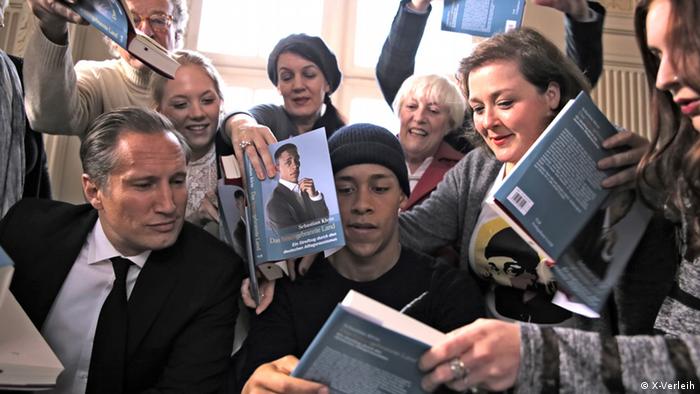Why Germany’s latest Nazi satire ‘Heil’ isn’t brave enough
Deutsche Welle
2015-07-16
Sarah Hofmann
 |
An unlikely spokesman
Neo-Nazi boss Sven (left, played by Beno Fürmann) celebrates a victory. He kidnapped Afro-German author Sebastian Klein (played by Jerry Hoffmann), who suffers from amnesia after behind hit on the head. Klein starts mimicking everything the neo-Nazis say.
|
An Afro-German starts talking like a neo-Nazi after the right-wingers beat him up in the new film satire, “Heil.” If Germany is going to laugh about Nazis, it should have a better reason to, says DW’s Sarah Hofmann.
It starts with a shock and the text “Deutschland 1945” on a black board. Cut. Historic footage of a Hitler speech. Cut. Piles of corpses in Bergen-Belsen. Cut. “Deutschland 1945” on a black board. Cut. One of the main characters in the film, a neo-Nazi, spraying “Wheit Pauer” – presumably intended to read “White Power” – and a swastika on a wall.
The first sequence in the film “Heil” lasts only five seconds. But the scenes are powerful. The audience stops laughing when the images jump from 1945 to 2015.
As a German in the audience, I find myself asking: Is that ok? Can images of Nazi crimes be used to evoke laughter without offending the victims? I decide that, yes, it can. But with one caveat: It has to hurt.
If the humor is black, then it should be bad.
How far can clichés be taken?
Nevertheless, even in 2015, Nazi jokes shouldn’t be turned into slapstick in Germany – and that’s the problem with “Heil.” The plot cannot be summed up in a few lines. It opens in Prittwitz, a fictional East German village that fulfills every cliché and is controlled by neo-Nazis. Afro-German author Sebastian Klein has a reading scheduled in this very town. Shortly after he arrives, he is beaten up and kidnapped by a bunch of neo-Nazis. The slapstick element comes when Klein suffers from amnesia after being hit on the head and mimics everything the neo-Nazis say for the rest of the film.
In talk shows, Klein rants xenophobic slogans. It’s a victory for neo-Nazi boss, Sven, who is competing with other neo-Nazi groups: the new Nazis in the West and the Nipsters. The latter dress like hipsters and know their way around social media, which gives them an advantage over the backward twits from Prittwitz. Then there are the local gangs that are just waiting for an opportunity to march into Poland again.
And Sebastian? His pregnant girlfriend – the epitome of the well-situated, hip Berlin mom – comes looking for him…
Read the entire article here.




